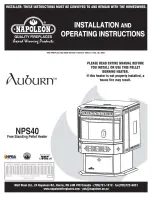
15
4.5.3 Holes for exhaust tube passage on walls or roof: recommended insulation and
diameter
Once the location of the stove has been decided (section 4.1), you will have to drill the hole for passage of
the fume exhaust tube. This varies depending on the type of installation (therefore on the exhaust tube
diameter, see 4.5.2) and on the type of wall or roof to be crossed (table 3).
The insulator must be of mineral origin (rock wool, ceramic fibre) with a nominal density greater than 80
kg/m3.
Insulation
thickness
[mm]
Fume exhaust tube diameter [mm]
Ø 80
Ø 100
Diameter of holes to be created [mm]
Wooden wall, or wall which
is flammable or has
flammable parts
100
280
300
Concrete wall or roof
50
180
200
Brick wall or roof
30
140
160
4.5.4 Using a traditional type chimney flue
If you wish to use an already existing chimney flue, it is advisable to have it checked by a professional chimney
sweep to ensure that it is watertight. This is because fumes, being slightly pressurised, could infiltrate cracks
in the chimney B y flue and invade living spaces. If an inspection finds that the chimney flue is not perfectly
intact, it is advisable to intubate it with new material. If the existing chimney is large, we recommend inserting
a tube with a maximum diameter of 150 mm. It is also advisable to insulate the fume exhaust duct. Figs. 11
and 12 demonstrate the solutions to adopt if you want to use an existing chimney flue.
Fig. 11
Fig. 12
















































